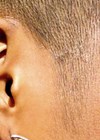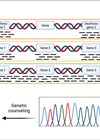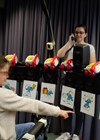Vestibular and balance disorders in children with hearing loss often go unrecognised. This article describes the significant impact such disorders have on the various aspects of children’s development. Vestibular and balance disorders occur in the paediatric population but can go unrecognised with significant developmental impact.
The underlying aetiologies are heterogeneous, and diagnosis remains the cornerstone for directing therapy and understanding outcomes. In this paper, we discuss recent publications which provide an update to our current understanding of vestibular and balance disorders in children.

Children can have vestibular hypofunction and balance disorders
There are many children with balance problems, and some will have vestibular deficits. The balance system is complex and composed of vestibular, auditory, somatosensory, and visual inputs that involve the brainstem, cerebellum and cortex [1]. Motor delay and balance dysfunction are the most common signs of diminished but stable vestibular disorders in children. Episodic vertigo, common in adults with vestibular dysfunction, can occur in children experiencing progressive vestibular loss, heralding an acute and relapsing reduction in vestibular end organ function over time. We are also learning that hearing is an important contributor to balance. Children with sensorineural hearing loss (SNHL) often display poor balance compared to typically developing children and are at greater risk for concurrent vestibular impairments due to the shared anatomical and histological building blocks within the inner ear [2].
Children with congenital cytomegalovirus (cCMV) infection are at risk for vestibular impairments
Congenital cytomegalovirus infection (cCMV) is the most common non-genetic cause of both SNHL and vestibular impairment in childhood. Virus-induced labyrinthitis targets the cochleovestibular system while the active infection can cause additional damage to the central nervous system [3]. Progressive, partial, or complete vestibular impairment appears to be even more prevalent than SNHL in children with cCMV, and is highly variable in presentation and onset, occurring even in children who are otherwise asymptomatic [3].
"Progressive, partial, or complete vestibular impairment appears to be even more prevalent than SNHL in children with cCMV, and is highly variable in presentation and onset"
With the recent advent of universal newborn cCMV screening protocols, the impetus to add screening measures for vestibular function has increased. The combined peripheral and central insults from cCMV may result in developmental delays and functional deficits which, in turn, limit or impair compensatory mechanisms. Many of these children experience motor delays and walking at a later age compared to their typically developing peers. Given the progressive nature of both the SNHL and vestibular impairment from cCMV, these children can also present with episodic vertigo.
Vestibular impairment can impact motor and cognitive development
Sensory deficits in early development impact how children learn to interact with the world around them. The ability to process and perceive reduced sensory information results in adaptations to compensate for the functional limitations [1,2]. It is important to also consider the allocation of cognitive resources in the presence of a vestibular impairment. Internal compensation mechanisms demand the use of additional cognitive resources simply to remain upright or to stabilise the visual field when vestibular inputs are impaired. The importance of the vestibular system in motor and cognitive development during sensitive periods remains underexplored, yet emerging evidence shows that children with vestibular impairment have deficits in balance, fine motor skills, gaze stabilisation, spatial memory, spatial navigation, mental rotation, attention, and reading [4].
Hearing and vestibular deficits can affect spatial perception
Without equal binaural inputs, spatial hearing and navigation can be compromised due to the inability to localise sound. Moreso, the lack of symmetrical input poses a risk for balance function [2]. A significantly high proportion of children (~50%) identified with unilateral hearing loss (UHL) also have impaired balance [4] and concurrent vestibular deficits [2]. Without spatial perception, children with UHL are vulnerable to experiencing developmental delays, specifically in the visuospatial and academic domains, and academic delays likely from an increased cognitive load from reduced perception of auditory space [4]. It is important to consider that concurrent vestibular impairments in children with UHL may exacerbate their deficits across all modalities resulting in further developmental delays. With this in mind, perhaps those children with unilateral cochleovestibular loss might benefit from cochlear implantation even more than traditional candidates with bilateral deafness.
Vestibular screening in early life is important
Our capacity to avoid effects of vestibular impairment on development is founded in early identification. An impending paradigm shift is in the works as early vestibular screening in infants has recently been reported [3,5]. Most vestibular and balance screening is currently being performed in at-risk populations, specifically infants with SNHL as well as those with cCMV. In a three-year review of early vestibular screening, abnormal vestibular screening results were found in 13.8% of more than 200 infants with SNHL [5]. Infants with SNHL who had the greatest risk for vestibular impairments had unilateral or bilateral severe to profound SNHL, syndromic hearing loss or SNHL from meningitis, cCMV or cochleovestibular anomalies [5]. In another study of >150 children with cCMV with or without SNHL, vestibular loss occurred before 18 months of age in 11.8% of the cohort and SNHL occurred at similar rates (14.2%). There was an association between SNHL and vestibular dysfunction as many, but not all, infants displayed both. Vestibular function can deteriorate with age even without worsening of hearing [3]. Furthermore, the presentation of vestibular function can be unilateral or bilateral, limited or extensive, stable or progressive, and early or delayed in onset [3] which emphasises the need for vestibular screening and regular vestibular follow-up, especially for at-risk patients. As we continue to screen at-risk children for vestibular and balance dysfunction, we should look towards a future where universal screening programmes for vestibular and balance function run parallel to our long-established hearing screening programmes.
Summary
Vestibular impairments are common and important to identify in children. These children suffer the cognitive costs of additional effort they require to maintain an upright posture. Unfortunately, mismatched sensory inputs deteriorate sensory integration which results in impairments across many domains. Understanding vestibular impairment and its impact on developmental outcomes is crucial to rehabilitate the deficits that arise from the sensory impairment. Few therapies exist to improve vestibular impairments and balance in children. Vestibular physiotherapy focuses on adaptation through compensation. Other emerging strategies that involve mapping the impoverished sensory input onto a functional one through auditory or biofeedback cues are currently being explored. However, early and accurate diagnosis of vestibular impairments, likely best achieved through screening, are necessary and required in order to develop a foundation for early intervention, a long-term treatment for these impairments, and a thorough understanding of outcomes.
References
1. Hecke RV, Deconinck FJA, Wiersema JR, et al. Balanced Growth project: A protocol of a single-centre observational study on the involvement of the vestibular system in a child’s motor and cognitive development. BMJ Open 2021;11(6):e049165.
2. Sokolov M, Gordon KA, Polonenko M, et al. Vestibular and balance function is often impaired in children with profound unilateral sensorineural hearing loss. Hear Res 2019;372:52-61.
3. Dhondt C, Maes L, Rombaut L, et al. Vestibular Function in Children With a Congenital Cytomegalovirus Infection: 3 Years of Follow-Up. Ear Hear 2021;42(1):76-86.
4. McSweeny CLS, Campos JL, Papsin BC, Gordon KA. Functional Consequences of Poor Binaural Hearing in Development: Evidence From Children With Unilateral Hearing Loss and Children Receiving Bilateral Cochlear Implants. Trends Hear 2021;25:23312165211051215.
5. Martens S, Dhooge I, Dhondt C, et al. Three Years of Vestibular Infant Screening in Infants With Sensorineural Hearing Loss. Pediatrics 2022;150(1):e2021055340.
Declaration of competing interests: SC: Speaker’s Bureau: Interacoustics, Cochlear Corporation. Sponsored Research Agreement: Cochlear Americas. Consultant: Decibel Therapeutics.












